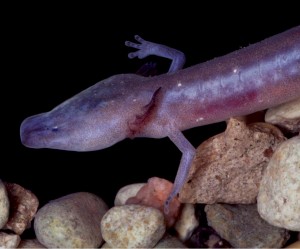Why the Fight Over Salamanders in Texas is Only Just the Beginning

Photo by Mose Buchele
Hundreds of people turned out at a recent public hearing in Round Rock to discuss the listing of four Central Texas Salamanders as Endangered Species.
When it comes to the battle over what qualifies as an endangered species, the script practically writes itself. The government proposes adding new animals to the list; business interests and land owners fight the proposal, fearing the financial impact; environmentalists rally around the critters, arguing for sustainability.
These days, it’s Central Texas’ turn. The creatures in question? Four tiny salamanders.
On a recent evening in the town of Round Rock in Williamson County, hundreds of people packed into a nondescript convention center just off the interstate to talk amphibians. Round Rock is a suburban Austin community, the second-fastest growing metro region in the country, and most of the people at the public hearing opposed listing the creatures.
The reasons varied. Some people didn’t seem to care whether the four species survived at all.
But most of those opposed to the listing were playing for time, arguing that a new study funded by local development interests was showing that the salamanders could thrive amid rapid suburban growth.
“Adequate time should be given to a decision like this that would have grave economic impacts, not just to private developers, but even to the counties, cities and school districts,” Valery Covey, a Williamson County Commissioner told U.S. Fish and Wildlife Service officials.
Then there were the rare voices in favor.

Photo courtesy of Dr. David Hillis
The Austin Blind Salamander is one of the species proposed to be listed as endangered.
“In Central Texas, we no longer have Bison, Pronghorn Antelope, red wolves or mountain lions. So I’m here supporting the listing of four finger sized salamanders none of which weighs more than a quarter,” Craig Nazor, a member of the Austin Sierra Club, said, while the room stayed noticeably silent. “Why? Because that’s what we have left.”
You can expect to hear a lot more of these kinds of debates in Texas over the next few years, as a glut of species are up for review by Fish and Wildlife, which runs the program, for classification as endangered.
A Taste of Things to Come
Why are so many species suddenly up for inclusion in the list? The reason is a legal settlement reached last year between the Service and conservation groups. The groups charged Fish and Wildlife with dragging its feet on classifying the animals. In the settlement, the Service agreed to propose 251 species for endangered status over a period of six years.
“So what you’re seeing now is the Service going through that work plan nationwide as part of that settlement agreement,” Adam Zerrenner, the Austin Field Office supervisor for Fish and Wildlife tells StateImpact Texas.

Photo by Mose Buchele.
Adam Zerrenner, with the US Fish and Wildlife Service's Austin Office, spoke at the hearing.
That lawsuit could significantly increase the number of endangered species listed. In the past ten years, an average of about 13 species were listed as endangered annually across the whole country. Now Texas, and the rest of the country, are bracing for fights over the proposed new listings. Among the 251 species included in the settlement now up for the endangered classification, 21 animals and plants are in Texas alone.
And once a species is proposed for listing, the clock starts ticking.
“Per that nationwide settlement agreement, these Salamanders, they had to be looked at this year and then finalized next year,” said Zerrener.
Notice he said, ‘finalized,’ not ‘listed.’ Earlier this year , another species that was proposed as part of the settlement, the Dunes Sagebrush Lizard, did not end up on the list, after an outcry from oil companies and ranchers in West Texas. Not to mention conservative Texas politicians.
Now, it could be the Salamanders turn.
Political Postures
Texas Representative John Carter has already filed a bill with Senator John Cornyn to block the listing of the creatures. He was also at the public meeting in Round Rock, making not-so-veiled threats to Fish and Wildlife officials.
“I still am here trying to be a cooperative member of Congress. If we can’t, I can also be an uncooperative member of congress,” Carter said, to a round of applause from the crowd.
Not all of the Texas species proposed for listing will draw the same level of opposition. But many, like the lesser prairie Chicken, and two species of fish likely will.
And all this will happen as new species continue to be discovered.
New to Science

Photo by Mose Buchele
Dr. David Hillis discovered the four species of salamanders that may be listed as endangered.
In his office recently at the University of Texas, Dr. David Hillis held up a small test tube in a plastic bag. He’s the man who discovered the four salamanders that are now causing such a stir, and from the looks of it, he’s just getting started.
“This is just a little juvenile Salamander that is actually of an undescribed species out in West Texas,” he said.
“We know that it’s a new species that hasn’t yet been formally given a name, but it’s one that we are currently working on.”
Hillis says he doesn’t like to involve himself in the politics of the endangered species listings. But one can’t help but wonder, as he describes the new West Texas species, whether this salamander will one day set off a whole new round of debate.



